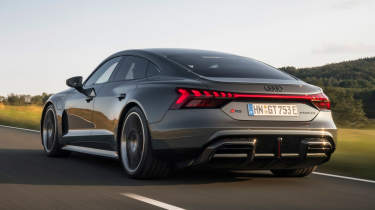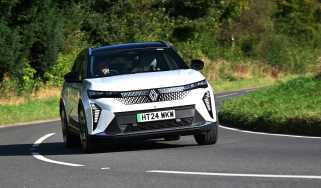New Audi RS e-tron GT 2024 review: more range boosts grand tourer appeal
The updated Audi RS e-tron GT promises plenty of fun from behind the wheel

Verdict
The Audi RS e-tron GT does a great job of mixing friendly driving dynamics with ludicrous power, plus there’s now real grand touring possibilities thanks to improved range and charging. It’s a shame the cabin lets it down – especially at this price point.
The new Audi RS e-tron GT wowed us earlier in the year when we got the chance to drive a prototype in Oman. Audi’s refreshed all-electric performance car has undergone plenty of changes for 2024, with a new battery, new electric motors, redesigned suspension and new trims to choose from. Now it’s time to try it out in production form.
The timing of the e-tron GT’s mid-life update is no surprise given its sister model, the Porsche Taycan, was tweaked earlier this year. Unlike the Taycan, however, which has an option of 82kWh and 97kWh batteries, the e-tron GT only gets the larger unit, as well as generally more equipment as standard. Despite its badge, it seems Audi is aiming ever higher, and in doing so creates some clean air for the newly-revealed A6 e-tron to occupy the slot beneath it.
In the top RS e-tron GT Performance Carbon Vorsprung trim level, the car takes the title as the most expensive Audi on sale at £166,330. We’ve driven both the entry-level S (from £107,730) and the range-topping RS e-tron GT Performance (from £142,830), but the one we’re focusing on is the mid-range, non-Performance RS e-tron GT, which starts at £126,330.
More reviews
There are a few visual differences between the S and the RS models, with a more aggressive body kit on the latter. But the e-tron GT still manages to stand out in everyday traffic despite the lack of huge exhausts you’d typically associate with RS-badged Audis.
The old car was lacking somewhat in the range department, but the new 97kWh battery is slightly bigger than before. That means the S can now officially travel 374 miles on a charge, with the RS topping out at 365 miles (up from 294 miles) – or 364 miles in RS Performance guise.
Not only does the e-tron GT provide better range than before, it’s quicker to recharge too. Changes to the hardware mean it can accept 320kW DC ultra-fast charging (up from 270kW), which is capable of replenishing the battery pack from 10 to 80 per cent in just 18 minutes. We tried this out at a random charging station, and saw an impressive 295kW on the screen readout.
While improvements to efficiency are welcome, it’s the dual-motor performance of the e-tron GT that has really skyrocketed with this facelift. The S now packs 669bhp (more than the old RS model), while the RS has a stonking 844bhp. If that’s not enough, the Performance package is the most powerful Audi to date – with 912bhp. It’s worth pointing out that those numbers are achieved via the ‘Boost’ function, which adds 93bhp for 10-second periods.
Rapid acceleration for EVs has become the norm with even the 2,725kg SQ8 e-tron SUV able to dispatch 0-62mph in 4.5 seconds. The RS e-tron GT Performance (which is around 375kg lighter) completes the sprint in 2.5 seconds, with the standard RS not too far behind at 2.8 seconds. Even the S model completes the benchmark sprint in 3.4 seconds.
During our acceleration tests we found the unrelenting way the RS e-tron punched off the line with no let up to be quite incredible. From the passenger side it somehow feels even more savage (and borderline unpleasant) so we’d recommend giving those riding shotgun a timely forewarning before showcasing the e-tron GT’s straight-line speed.
For well over £100,000 you also want your sports saloon to deliver in the bends, and the Audi ticks this box, too. The steering ratio has been tweaked with great effect, working in conjunction with the now standard-fit adaptive air suspension that creates greater front-end feedback and immediate response to inputs that belies the RS e-tron GT’s weight.
That air suspension has been re-worked too with two-chamber technology allowing it to perform better on tight, twisty roads. Coupled with upgraded rear-wheel steering, the RS e-tron GT feels way more agile than its sizeable 2.9-metre wheelbase would suggest. The weight is noticeable during sudden changes of direction, but the model-specific Bridgestone Potenza Sport tyres provide ample amounts of grip. If you should feel inclined to switch the electronic stability control to ‘Sport’ you’ll find a little bit of slip from the rear-biased powertrain, which the quick-witted steering can correct at ease.
At a standstill it’s possible to raise or lower the ride height of the RS e-tron GT through a selection of driving modes (Efficiency, Comfort and Dynamic). In Comfort, we found the balance of grip to be a little light at the front upon acceleration, but this can be fixed by lowering the front end as much as possible.
Another clever aspect of the air suspension is the ‘comfort entry’ setting, which raises the car by 22mm when a door is opened, to make entry easier. It’s perhaps a little startling at first, but you quickly adjust; it’s a useful bit of technology in the low-slung e-tron GT.
Something we’d like a little more of is brake recuperation. Audi has doubled the strength of the regeneration with the new car, but there’s no option of one-pedal driving and the overall feeling doesn’t quite manage to mimic traditional engine braking. The physical brakes themselves are outstanding, however. The normal RS gets tungsten carbide-coated steel brakes rather than the Ceramic brakes of the RS Performance, but you’ll not be left wanting for stopping power, or overall feel from the brake pedal.
You get 20-inch wheels as standard on the S, while the RS models get 21-inch rims instead. There’s a slight trade off in comfort between the two wheel sizes as we found the smaller wheels better at filtering out imperfections in the road at low speeds. At a cruise, however, there’s no perceivable difference in ride quality between the two. On smooth German roads we found the RS e-tron GT to be cosseting enough to earn its ‘grand tourer’ label from Audi.
While the seats in the e-tron GT look sporty and can provide support when you want to lean on the car’s dynamic qualities, they’re surprisingly comfortable too. The driving position creates clear visibility to the front with the windscreen not sitting too far away and a relatively high seat base. The bonnet line is a little tall though, and the view out of the rear window is pretty abysmal. The e-tron GT is easy to pilot around town, but you’re acutely aware of its near-two-metre width.
A slight novelty in a premium electric car is the selection of physical switches on the dash. You might recognise them from lesser Audi models, but they work well. The screens are also carried over: a 10.1-inch display in the centre of the dashboard and a 12.3-inch Virtual Cockpit screen. We experienced some issues with the central screen in one of the cars where it kept fading to black, but overall they’re responsive to inputs and the resolution is clear. They display a lot of information, however, so unless you’re experienced with Audi’s infotainment already, you’ll need a few days to adjust.
Elsewhere, there are some touches to the cabin that we found a little disappointing given the e-tron GT’s price tag. The touch sensitive volume control in the centre console is infuriating to use on the move, and you’ll be likely asking your local Audi dealer if a retrofit of the previous car’s steering wheel (with its physical switches) is possible, given the fiddly nature of the touchpads on the new wheel. The USB-C charging ports located under the central armrest are a faff to use, too.
There’s enough space in the rear for tall adults to get comfortable, but as you’d probably expect given the sleek bodystyle, it’s not particularly roomy back there. You can specify a panoramic glass roof that can turn opaque, though this is annoyingly operated via a menu in the touchscreen rather than a more traditional button overhead.
| Model: | Audi RS e-tron GT |
| Price: | £126,330 |
| Powertrain: | 97kWh battery, 2x e-motors |
| Power/torque: | 844bhp/895Nm |
| Transmission: | Single-speed automatic, four-wheel drive |
| 0-62mph: | 2.8 seconds |
| Top speed: | 155mph |
| Range: | 365 miles |
| Max charging: | 320kW (10-80% in 18 min) |
| Size (L/W/H): | 4,997/1,964/1,389mm |
| On sale: | Now |













